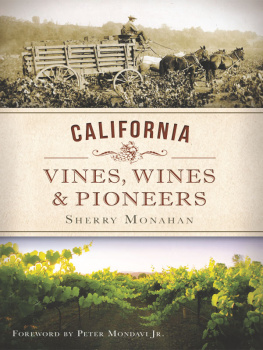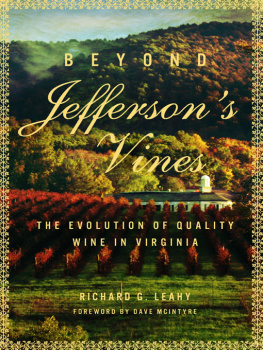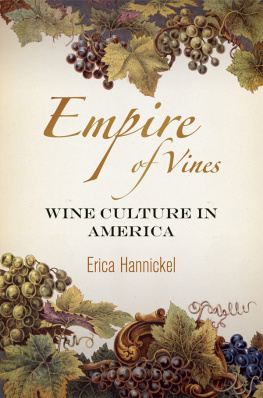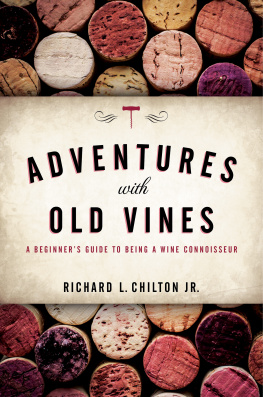
Published by American Palate
A Division of The History Press
Charleston, SC 29403
www.historypress.net
Copyright 2013 by Sherry Monahan
All rights reserved
Cover images: Front: Italian Swiss Colony harvest wagon. Courtesy of Asti Winery, Treasury Wine Estates; Hall-Bergfeld Vineyards. Courtesy of Hall Wines.
First published 2013
e-book edition 2013
Manufactured in the United States
ISBN 978.1.61423.894.2
Library of Congress CIP data applied for.
print edition ISBN 978.1.60949.884.9
Notice: The information in this book is true and complete to the best of our knowledge. It is offered without guarantee on the part of the author or The History Press. The author and The History Press disclaim all liability in connection with the use of this book.
All rights reserved. No part of this book may be reproduced or transmitted in any form whatsoever without prior written permission from the publisher except in the case of brief quotations embodied in critical articles and reviews.
To my husband Larry, V.2, for making dinners and everything else the spouse of a deadline-driven author does. To my friend Chris Enss, who despite downturns in life is rarely seen without a kind smile or a funny quip.
To all my family and friends who have always listened and supported me.
Thanks!
CONTENTS
FOREWORD
Reading through California Vines, Wines & Pioneers took me back to my childhood. Names of towns, streets, businesses, wineries and vineyards all sparked fond memories of growing up in Napa Valley. The people behind the names had little significance to me back then, but they have emerged over the decades as the bedrock of our industry. Author Sherry Monahan has written a thorough and intriguing account of California wines founding fathers (and, more rarely, mothers). She has bridged the gap between these nineteenth-century visionaries and the omnipresent and international wine businesses of the twenty-first century whose seeds were, in fact, planted by those visionaries generations ago.
Ms. Monahans story vividly captures the foresight and determination of these pioneers and the challenges they faced as they wrote the history of the Wild West. She also ferrets out the histories of our founding families, tracing them back to their homelands. The impressive role that Europe played in shaping this nascent California trade is worth noting. All of these wine pioneers came from the quintessential wine growing countries of Europe with their Old World wines. She eloquently describes their arrival, some through very circuitous routes, and the journey to planting vines and vinifying their fruit. From eclectic backgrounds and of mostly modest means, they shared a determination to overcome anything in their way. For some, obstacles such as phylloxera and prohibition proved too daunting, but more often than not, failed endeavors were later reborn under new owners with new visions.
California Vines, Wines & Pioneers impressively chronicles the grape varieties that were planted at the dawn of our industry. These varieties were as varied as their owners origins, but the common grape connecting many growers and vintners was Cabernet Sauvignon, a vestige of their Old World heritage. These nineteenth-century immigrants came full circle by shipping their wares back to the Old World, competing against their European counterparts and garnering prestigious awards in the process. History repeated itself with the Paris Tasting of 1976 when California wines again prevailed, as they often had the century before.
Sherry Monahans stories, bolstered by her passion for genealogy and historical research, have broadened our knowledge of the founders and descendants of the California wine business. Stories have always been used to sell bottles of wine. We now have more stories, accurately told, that bring life to our industry. Her book celebrates the lives of the Old World settlers and the visionaries who shepherded the historic wineries and vineyards, and California wine, into the present.
This work adds a new dimension to the terroir that we taste in our wines today. Next time you enjoy a glass, toast our history. I know I will.
Salute,
Peter Mondavi Jr.
Co-proprietor, Charles Krug Winery
ACKNOWLEDGEMENTS
There are so many people I need to thank for helping me with this book. First, to my wine people, David and Jennifer Faircloth. While sampling some Seghesio wine in their shop, they told me about Edoardos story, and thats when I got the idea to write this book. To The History Press and my commissioning editor, Aubrie Koenig, for accepting my idea. To my dear and nutty friend, author Chris Enss. Her tireless efforts to help me get endorsements and publicity for this book went beyond the call of friendship duty. To the wineries and their staff for taking the time to share their history, their family stories and their wine! Special thanks to Peter Mondavi Jr. of the Krug estate, Anna Miranda and the Count at Buena Vista, Joel Peterson at Ravenswood and James and John Concannon of Concannon Family Vineyards. Thanks also to these wineries: Bucklin, Edmeades, Far Niente, Foppiano Vineyards, Freemark Abbey, Frogs Leap, Fulton, Hall/Bergfeld, Inglenook, Korbel, Kunde, Langtry Estates, Nichelini, Saucelito Canyon, Schramsberg, Scott Harvey, Sebastiani, Seghesio, Trefethen, Valley of the Moon, V. Sattui and Wente. Special thanks to Harlan Hague for connecting me to Dana DiRicco and her husband, Glenn Benjamin, DVM, who gave me room and board in Lake County, and for connecting me to her friend Carole Mascherini. Carole and her husband, Gino Ballaghio, offered us a place to stay in Healdsburg that was nestled among Chardonnay vines.
Additional thanks to everyone who shared their winery or vineyard histories, family stories, wine samples, recipes, photographs and personal details. Having those things make this book more of a personal story rather than just straight facts. Most importantly: thanks for your time.
INTRODUCTION
Today, Napa, Sonoma and other Northern California regions are synonymous with California wine, but that wasnt always the case. It was the Franciscan missionaries sent over from Spain who planted the first grapes in Southern California. As they migrated north from Mexico, they set up missions beginning with San Diego in 1769 and ending with Sonoma in 1823, planting grapes along the way. They planted a grape called the mission grape or criolla medina.
By 1831, Los Angeles had blossomed into the largest grape growing region in California, and Hubert H. Bancroft noted that the city of Los Angeles had more than one hundred acres of vineyards, with nearly half of the 200,000 vineyards in the country. Some of the largest producers were the local missions. According to William Heath Davis, who arrived in California in 1831, Frenchman Jean Louis Vignes was the first man to establish a nonmission vineyard. Vignes is credited with being the first to introduce Vitis vinifera to California, which are cultivated European grapes. In his 1886 book Sixty Years in California: A History of Events and Life in California, Davis called Vignes the father of the wine industry. He was also the first to plant and cultivate oranges in Los Angeles. The city of Los Angeles flourished as the California wine hub for several years, until a little discovery at Sutters mill created an increased demand for local wine in mining areas.
Californias population boomed when news of the gold rush broke in mid-1848 from Sutters Camp in Coloma. By the end of 1849, some eighty thousand immigrants from France, Italy, China, Germany, Hungary and other countries had come to seize their dreams of a golden fortune. By 1852, many knew that their chance of realizing that dream was no closer than when they arrived.
Next page









